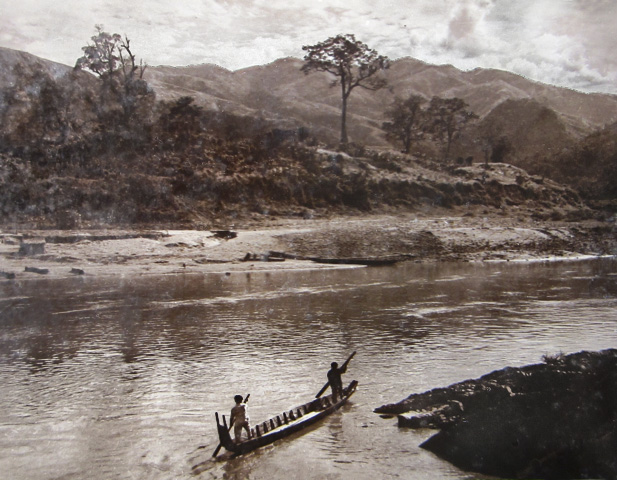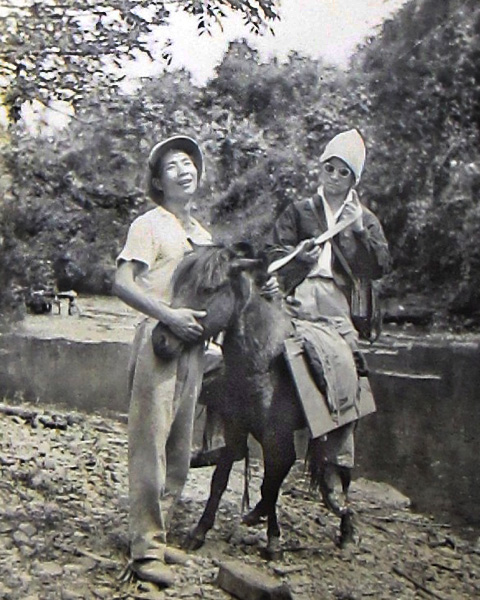Chapter Two
The year was 1960. The Thái-Mèo Autonomous Region embraced eighteen districts. In 1963 it was reorganized as the Northwest Autonomous Region, consisting of the three provinces of Lai Châu, Sơn La, and Nghĩa Lộ. The cultural cadres of Thuận Châu thereupon split up to work in the new provinces.
Mr. Lương Quy Nhân was appointed the chief of Lai Châu’s Department of Culture. He brought along a number of younger associates, including me and Đặng Trần Sơn. Those sent out to Lai Châu were regarded as people endowed with a spirit of volunteerism, who were able to endure difficulty and hardship.
The list included some twenty names, but some returned to the lowlands, some went on leave, and some went on other missions… leaving only me and Đặng Trần Sơn to go all the way to that location with Lương Quy Nhân. The two of us were thus regarded as the first staff to join the nascent Lai Châu Department of Culture.
The “headquarters” of the department were initially established in the mansion of Đèo Văn Long, once the King of the Thai region, located at the three-river crossing where the Nậm Na and Đà Rivers converge to form a larger river flowing into the lowlands. On the other side is Mường Lay. The entire multi-room mansion of the Thai King was abandoned—it was now only a place to tether horses before crossing the river. People from Mường Tè and Phong Thổ would pass through the area.
The natural surroundings were of extraordinary grandeur, reflecting the awesome, limitless power of the Creator. The river waters rushed on impetuously like waterfalls, humming and resounding throughout the day and night, from one generation to another, from one century to another, from one millennium to another, since the creation of Heaven and Earth. The stones, as small as marbles, or as big as a room, were all utterly smooth and round. When one looked from a mountaintop at the rising sun, the jutting peaks of layered mountain ranges below looked like the backs of so many camels lying at rest on the ground.

Like a series of pictures floating past the frame, now fast, now slow—as if they were scenes projected on a screen going on ceaselessly from day to day and month to month. (A view from the mansion of Đèo Văn Long).
One room in the villa had a great square window, through which the spectacle of peaks, rivers, clouds, jungle rain, mountain winds, glowing sunsets, and long, deep nights was like a series of pictures floating past the frame, now fast, now slow—as if they were scenes projected on a screen going on ceaselessly from day to day and month to month.
Of all the people who passed through this crossing—laborers transporting goods on horseback, or “Xòe” dancing girls in the heyday of the Thai King—where are their souls now?
On the wall, hanging on either side of the window, were a measuring stick and a mirror. With no conscious intent whatsoever on the part of this curious young man, these things—the measuring stick and mirror next to the window—came one day to symbolize honesty and integrity in my dreamy imagination. And that thought began gradually to merge with my experience of the great hardships and upheavals of life, even when my hair had turned gray and my eyes had dimmed…
Was this an omen appearing already in my early youth in the abandoned mansion in the Northwest so long ago? A square “picture screen,” with vivid “film scenes,” a measuring stick and a mirror…
Đặng Trần Sơn and I would go into the jungle day in and day out to gather firewood, descend to a stream to fetch water for rice cooking, and then focus on their assignments. At night, fearing that tigers might come to stalk them, we would bang bamboo pipes on the floor in rhythm and sing at the top of their lungs. One may say that this was a beautiful stretch of life that contributed much to the character of two youths just setting out on their career paths.

This was a beautiful stretch of life, that contributed much to the character of two youths just setting out on their career paths. (November 1963: the two young men, while traveling on the road from Điện Biên to Mường Lói, had just captured a stray donkey, and were “using” it to transport goods.)
It was just like these familiar lyrics of bygone days: winding paths that seemed to have no end, going up and down rolling hills, twisting and turning. Sometimes, next to a stream, you could hear the leisurely sounds of a water-powered rice-hulling apparatus thump-thwack, thump-thwack, a sound that went on day and night, thump-thwack, thump-thwack, as slow and measured as the sound of time itself. This thing “worked” by itself all alone, without any shadow of a companion. The owner of the rice-husking apparatus might have been nearby, or hours away by foot. There were people passing through who would sit down and help turn the rice, or scoop it out if the grains were sufficiently white already, and then pour in more un-husked rice. The rice was placed in plaited backpacks lying right next to the mortar.
Every now and then, we would come upon an empty thatched hut by the path, inside which clusters of bananas hung, along with sweet potatoes or cassava roots, bamboo shoots, ears of corn, batches of eggs, and even chicken. Whoever needed anything could simply take it and leave some money in an adjacent basket.
I don’t know how the simple people native to that locality referred to these places—perhaps they cared little about giving them a name. Later, when the Kinh people (the Vietnamese; that is, the majority ethnic group) came up there, they invented a name for them with a nice revolutionary flavor: “voluntary shops” (quán tự giác). Having been given such an attractive name, these places soon breathed their last goodbye and “voluntarily” died, because the goods inside them disappeared, and the money baskets remained empty. Anyone who knew and saw those lovely little shops along the wayside will surely feel some pain and regret when they remember the term “voluntary shop.”
The thatched shops are shattered and the water-run rice mortars abandoned. The Kinh people are like jungle demons; wherever they go, places endowed by nature with interest and beauty go to ruin, or are made to look more “interesting” and “beautiful,” before they… die. The innocent soul of the jungles and mountains is frightened away. Ah those Kinh… they are terrors to the jungles and mountains.1
November 26, 1960 was the day that I turned twenty. A little past 4:00 in the morning, I began to climb the Mường Mô mountain slope. Not until mid-day did I reach the top and gaze at the distant houses down below, where some blue smoke was rising. This was where the district office of Mường Tè was located, but one had to walk on until dusk to get there. Mường Tè was the district most remote from Lai Châu and also the whole Northwest. People say that when a rooster crows there, the sound can be heard in three countries. There were no decent roads there, only trails traversing slopes and streams. This was the land of the most primitive tribes.
I was there on an anthropological mission; my task was to seek to understand the nomadic tribes of that region and to produce written accounts concerning them. The location names there sound strange to the ear: Ca-lăng, Té Xứ, Pa Ủ, Pa Vè Xủ, Mali Pho, Mali Chải. These places were then inhabited by such ethnic peoples as the Hà Nhì or U Nhí, the Khù Xung (meaning “suffer together”), and the Toong Lương (meaning “yellow leaf”). In his various expeditions, I lived with “primitive” folk who wore only bits of grass to cover their lower bodies and nothing above. They kept some tools to make fire with stone, to cut bamboo to make simple dwellings, gather banana leaves to shield them from the rain and sun, and dig up patches of earth large enough to enable their groups to reside there. They were still attached to cave-dwelling ways of life. When things to eat grew scarce with the disappearance of fruits, tubers and game, and the thatch on their huts had turned yellow, then they would move on…
In 1960, when frontier troops first came upon them, these people were still living in a very primitive manner. They used water only to drink; there was little concept of bathing. In a pit where they were accustomed to assemble, they used thick bamboo stalks to make a frame platform for me to lie on, while they themselves lay on the dirt below. In the evenings they would make a fire, call and croon a bit, and then stretch out next to each other to go to sleep. On nights when Thủy grew wakeful, he would see the fire nearly extinguished, while his hosts lay embracing each other in a belt-like circle—it was impossible to see where it began and where it ended. They practiced group marriage, and went everywhere in bands; they had offspring, but had no idea to whom they belonged.
I investigated the lives, activities, habits, and origins of several other ethnic peoples as well, and made careful notes for anthropological reports that I sent back to Hanoi.
| 1 | “Kinh people” means the mainstream majority group living in the lowlands of Vietnam. They are here said to resemble “jungle demons” because of their big brother attitude and aggressive approach, which can create havoc among ethnic minority peoples who live more humbly. (translators) |
Order In Whose Eyes from the University of Massachusetts Press, or from Amazon.
All text and images are © 2023, Trần Văn Thủy, all rights reserved. Written permission is required for any use.